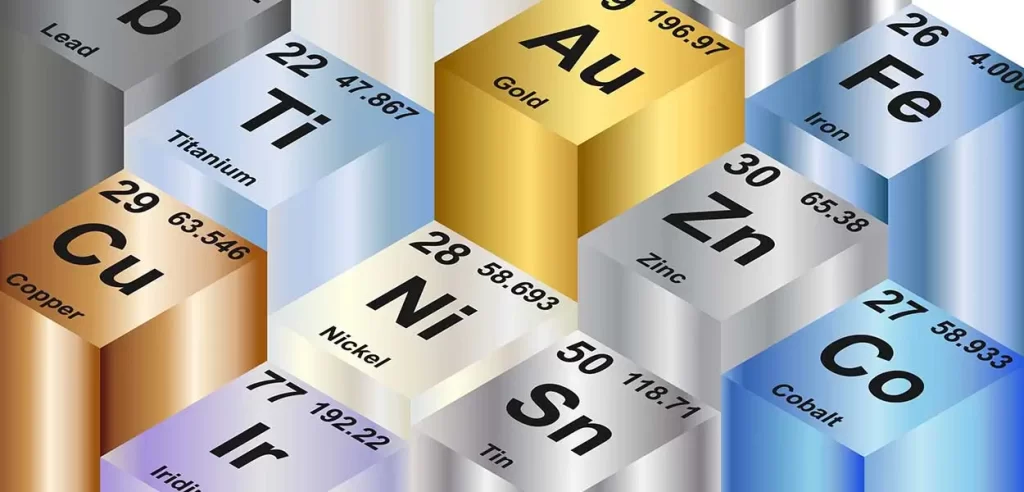Definition of Metals
Metals are a class of elements distinguished by their high electrical and thermal conductivity, malleability, ductility, and lustrous appearance. These properties arise from the unique nature of metallic bonding, where electrons are delocalised and free to move throughout the structure. Metals are typically solid at room temperature, with the exception of mercury, which is liquid.
Examples of Metals

Metals are broadly categorised into several groups including ferrous and non-ferrous metals. Here are a few examples from each category:
1. Ferrous Metals:
- Iron (Fe): The most commonly used metal, essential for the production of steel.
- Steel: An alloy of iron and carbon, with varied properties depending on the alloying elements and heat treatment processes.
2. Non-Ferrous Metals:
- Aluminium (Al): Known for its lightweight and corrosion resistance.
- Copper (Cu): Excellent electrical conductivity, used in electrical wiring.
- Gold (Au): Highly conductive and resistant to corrosion, often used in electronics and jewellery.
- Silver (Ag): The highest electrical conductivity of all metals, used in electronics and jewellery.
- Titanium (Ti): Strong as steel but much lighter, used in aerospace and medical implants.
Characteristics of Metals
Electrical and Thermal Conductivity:
Metals are excellent conductors of electricity and heat due to the free movement of electrons within their structure. This makes them ideal for electrical wiring and components, as well as for use in heat exchangers and cooking utensils.
Malleability and Ductility:
Metals can be hammered or rolled into thin sheets (malleability) and drawn into wires (ductility) without breaking. This property is crucial for manufacturing processes that shape metals into desired forms, such as automotive body panels and metal foils.
Luster:
Metals have a shiny appearance when polished, which is due to their ability to reflect light. This characteristic makes them desirable for decorative applications, including jewellery and architectural elements.
High Density and Strength:
Most metals are dense and strong, which is why they are used in construction and manufacturing. For instance, steel is used in building frameworks, bridges, and machinery due to its high strength-to-weight ratio.
Corrosion Resistance:
Some metals, like aluminium and stainless steel, form a protective oxide layer that prevents further corrosion, making them suitable for use in harsh environments.
Magnetic Properties:
Certain metals, such as iron, cobalt, and nickel, exhibit magnetic properties, making them useful in the production of magnets and electromagnetic devices.
Uses and Applications of Metals
1. Construction:
- Steel: Used in the construction of buildings, bridges, and infrastructure due to its high strength and durability.
- Aluminium: Employed in window frames, roofing, and exterior cladding for its corrosion resistance and lightweight properties.
2. Transportation:
- Automobiles: Steel and aluminium are extensively used in the manufacture of car bodies and engines.
- Aerospace: Titanium and aluminium alloys are critical for constructing aircraft due to their high strength and low weight.
3. Electronics:
- Copper: Essential for electrical wiring and components because of its excellent electrical conductivity.
- Gold and Silver: Used in high-end electronics and connectors due to their superior conductivity and resistance to corrosion.
4. Medical Applications:
- Titanium: Used in medical implants, such as joint replacements and dental implants, due to its biocompatibility and strength.
- Stainless Steel: Employed in surgical instruments and medical devices because of its corrosion resistance and ease of sterilisation.
5. Everyday Items:
- Aluminium Foil: Used for packaging and cooking due to its malleability and non-toxicity.
- Cutlery and Utensils: Made from stainless steel for its durability and resistance to rust.
6. Energy Sector:
- Uranium: A critical metal used as fuel in nuclear reactors.
- Steel and Copper: Used in the construction of power plants and electrical transmission lines.
Conclusion
Metals are integral to modern civilisation, providing essential properties that make them suitable for a wide range of applications. From the construction of towering skyscrapers to the intricate circuits in smartphones, metals are indispensable due to their unique characteristics. Understanding the diverse roles metals play in various industries highlights their importance and the ongoing need for innovation in metallurgy to meet future demands.




